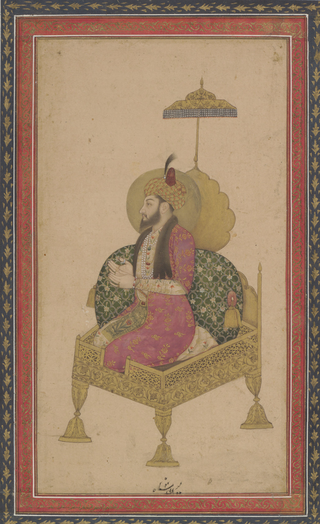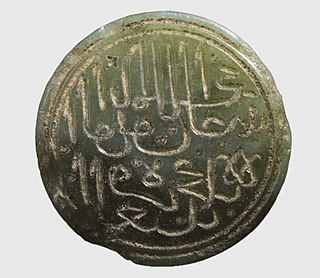Related Research Articles

Sharaf ad-Din Ali Yazdi or Sharif al-Din Ali’ Yazdi, also known by his pen name Sharaf, was a 15th-century Persian scholar who authored several works in the arts and sciences, including mathematics, astronomy, enigma, literature such as poetry, and history. The Zafarnama, a life of Timur, is his most famous work.

Shah Rukh or Shahrukh Mirza was the ruler of the Timurid Empire between 1405 and 1447.

Mirza Jalal-ud-din Miran Shah Beg, commonly known as Miran Shah, was a son of the Central Asian conqueror Timur, founder of the Timurid Empire.
Shaikh Hasan, also known as "Hasan Buzurg", Hassan the Jalair or Hassan-e Uljatâï was the first of several de facto independent Jalayirid rulers of Iraq and central Iran.

Shaykh Uways Jalayir was the Jalayirid ruler of Iraq (1356–1374) and Azerbaijan (1360–1374). He was the son of Hasan Buzurg and the Chobanid princess Dilshad Khatun.

The Jalayirid Sultanate was a Mongol Jalayir dynasty which ruled over modern-day Iraq and western Iran after the breakup of the Mongol khanate of Persia in the 1330s. It lasted about fifty years, until disrupted by Timur's conquests and the revolts of the Qara Qoyunlu Turkoman. After Timur's death in 1405, there was a brief attempt to re-establish the sultanate in southern Iraq and Khuzistan. The Jalayirids were finally eliminated by the Qara Qoyunlu in 1432.
Sultan Ahmad was the ruler of the Jalayirid Sultanate, he was son to the most accomplished ruler of the sultanate, Shaykh Uways Jalayir. Early in his reign, he was involved in conflicts with his brothers. He would later suffer from several defeats with Timur and eventually imprisoned by the Mamluks. After being set free, he attacked his old enemy, the Qara Qoyunlu but was later captured and executed 1410.
Zafarnama is the title of a number of Persian and Turkish literary works

The Garrett Zafarnama is an early manuscript of the Zafarnama by Sharaf ad-Din Ali Yazdi now in the Johns Hopkins University Library in Baltimore, Maryland, USA.
The Battle of Algami Canal was fought between Kara Koyunlu under their Bey, Qara Yusuf and the Timurid Empire under the leadership of Timur's grandson Abu Bakr bin Miran Shah for control of Baghdad and therefore Iraq in late 1402.

The Battle of Nakhchivan was fought between Kara Koyunlu under their Bey, Qara Yusuf and the Timurid Empire under the leadership of Timur's grandson Abu Bakr ibn Miran Shah, for control of Azerbaijan on October 14, 1406. Qara Yusuf decisively defeated the Timurids in this battle and took over Tabriz, the capital of the region.
The Zafarnama is a biography of Timur written by the historian Nizam al-Din Shami. It served as the basis for a later and better-known Zafarnama by Sharaf ad-Din Ali Yazdi.

Qara MahammadTöremish was a bey of Qara Qoyunlu and father of Qara Yusuf.

Mu'iz-ud-din Umar Shaikh Mirza was a member of the Timurid dynasty and a son of its founder, the Central Asian conqueror Timur. Known for being a skilled soldier, Umar Shaikh was one of Timur's military commanders and also served as a regional governor. He died in 1394, predeceasing his father by over a decade.

The Zafarnama is a panegyric book written by Sharaf al-Din Ali Yazdi approximately two decades after the death of its main subject, Timur, the Turco-Mongol conqueror. It was commissioned by Ibrahim Sultan, Timur's grandson between 1424–28, and remains one of the best-known sources of Timur's life. The text was written using the notes taken by royal scribes and secretaries of Timur, suggesting that the history of the book was based on a careful and desired selection of facts.
Qarachar Noyan, also spelt Karachar, was a Mongol military commander under Genghis Khan as well as a paternal ancestor of Timur, founder of the Timurid Empire.
Khvaja Mahmud-i Haydar was an Iranian statesman and military commander (sardar) who initially served the Timurid Empire, but shifted his allegiance to the Qara Qoyunlu after its ruler Jahan Shah captured his native city of Isfahan in 1452. Mahmud Haydar soon died afterwards.
Gayur Khan or Kyr Bek was the king of Simsir in the 14th century. He was involved in the Timurid invasion of the Caucasus and was recorded in the two Persian chronicles: Zafarnama by Nizam al-Din Shami and the Zafarnama by Sharaf ad-Din Ali Yazdi.
Sequ Sechen Barlas or, Suqu Sechen mean was a Borjigin Prince and Advisor, military commander of the Khamag Mongol Confederacy, he was serving Ambaghai Khan, Hotula Khan, and the father of Genghis Khan Yesükhei Bagatur at the Suqu was the father of Qarachar Barlas who was the Foundation of Barlas Clan which is sub-branch of borjigin and the paternal ancestor of Timur, and the father of Qubilai Barlas the one of four hounds of Genghis Khan, as well as the father of Tuqachar Kuregan who was the ''son-in-law'' and military commander of Genghis Khan. he was the son of Erumduli Barlas who was the Grandson of Tumbinai Khan who was the Khan of Borjigin Mongol.
Anka Tore, also Enge Tore, was an Emir of a large Ulus in Moghulistan. He is mentioned in the works of Zafarnama Yazdi, Zafarnama Shami and Mojmal al-Tawarikh. He fought against Timur for dominance in the region.
References
- 1 2 3 4 5 6 Jackson 1997.
- ↑ Woods 1987, p. 85-87.
- 1 2 3 4 Binbaş 2016, p. 173.
- 1 2 3 4 Woods 1987, p. 85.
- ↑ May, Timothy; Hope, Michael, eds. (2022). The Mongol World. Routledge. pp. 1–1068.
- 1 2 3 Woods 1987, pp. 85–87.
- ↑ Woods 1987, pp. 83, 87.
- ↑ Subtelny & Melville 2002, pp. 507–509.
- ↑ Balabanlilar 2020, p. 205 (note 4).